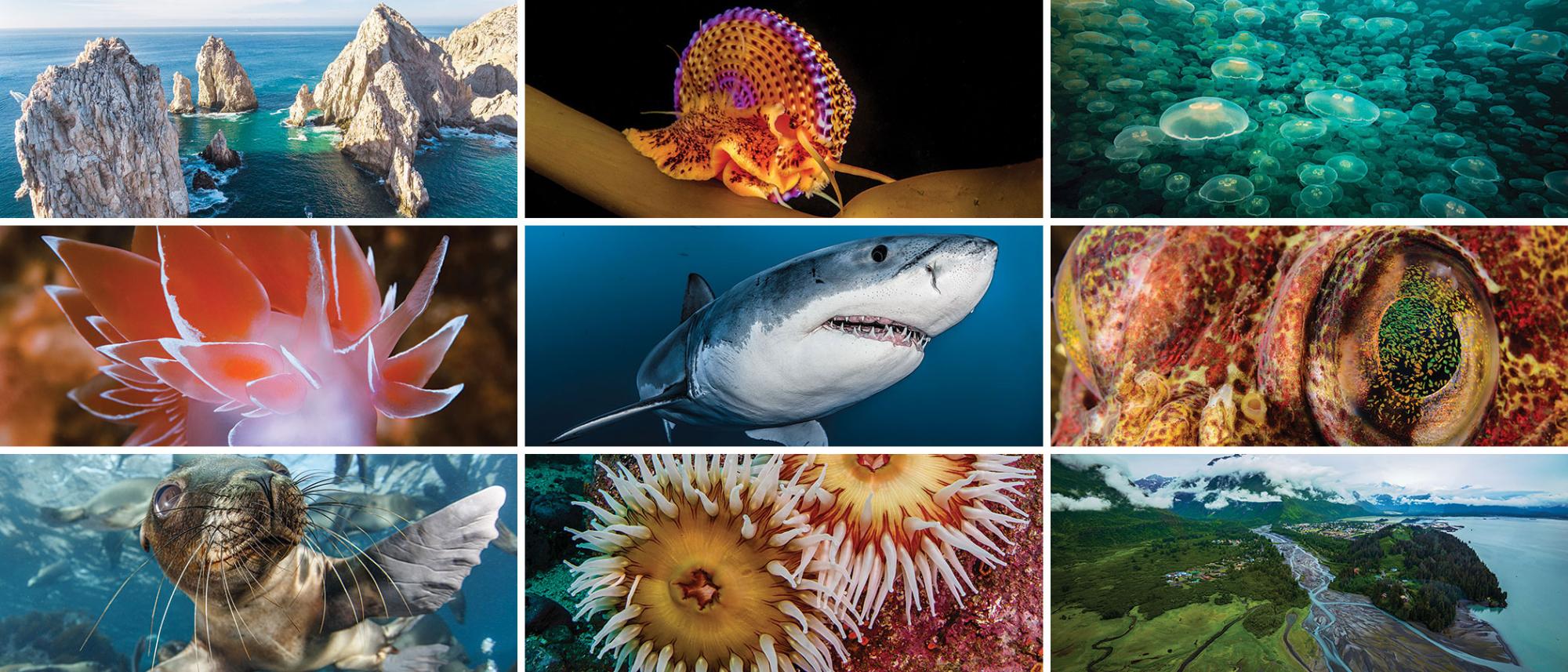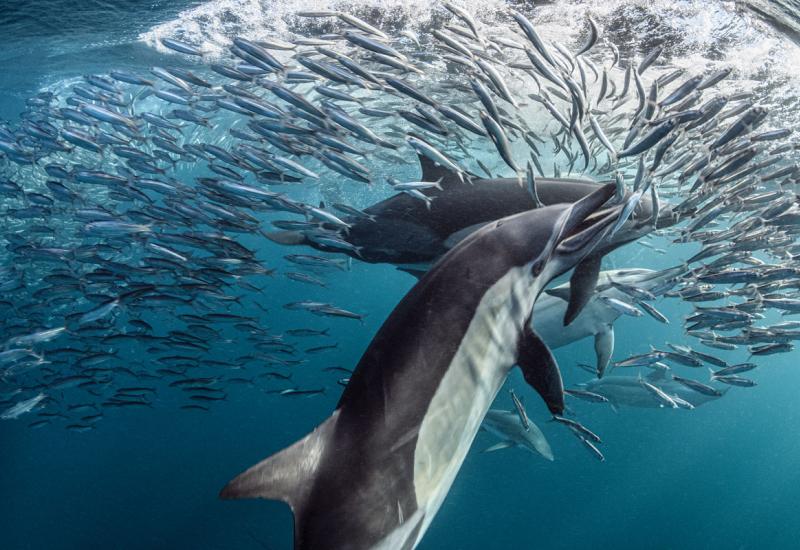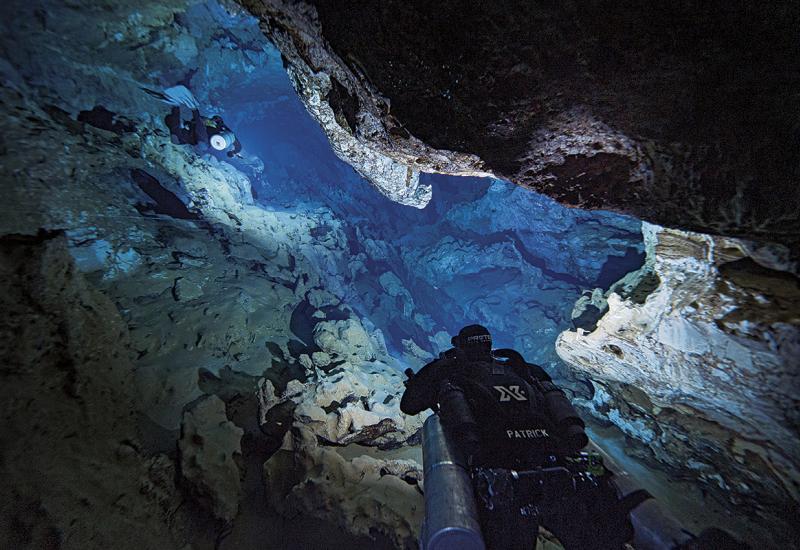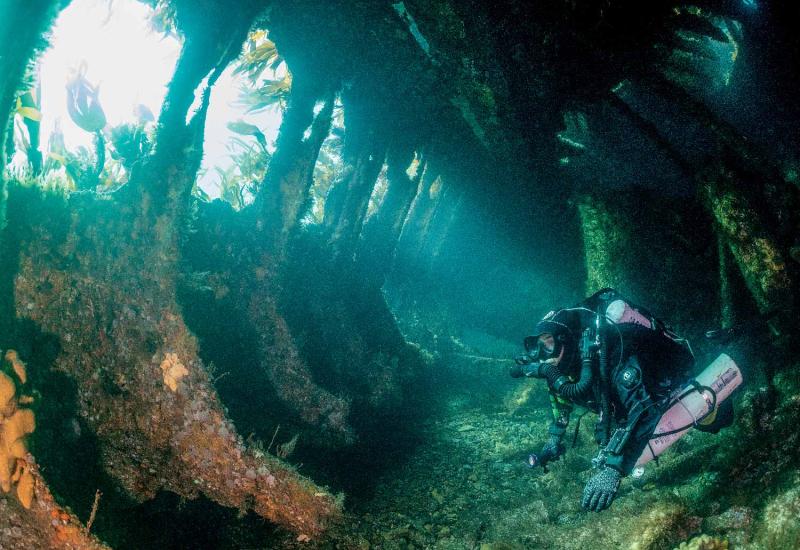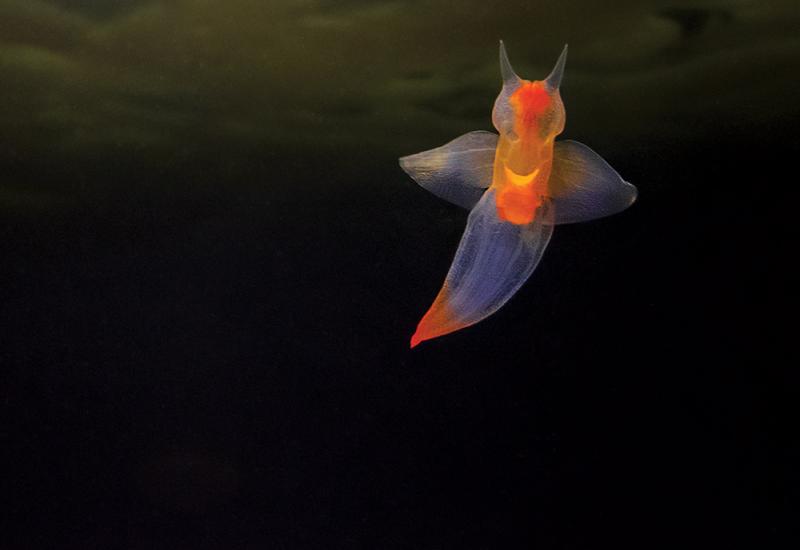The Best Pacific Coast Diving in North America
^^I^^t’s 3,000 miles as the crow flies, more or less, from Prince William Sound, Alaska, to Cabo San Lucas, at the tip of Baja California Sur, Mexico. What do the stops along this mammoth stretch of rugged, heartbreakingly beautiful coastline have in common? Great diving, at spots from Port Hardy, British Columbia, to Puget Sound; Monterey, California, to the Channel Islands; and Isla Guadalupe to the famous Arch at Cabo’s Land’s End.
There are common sights — pinnipeds, anyone? — but far more that’s unique, and worth exploring.
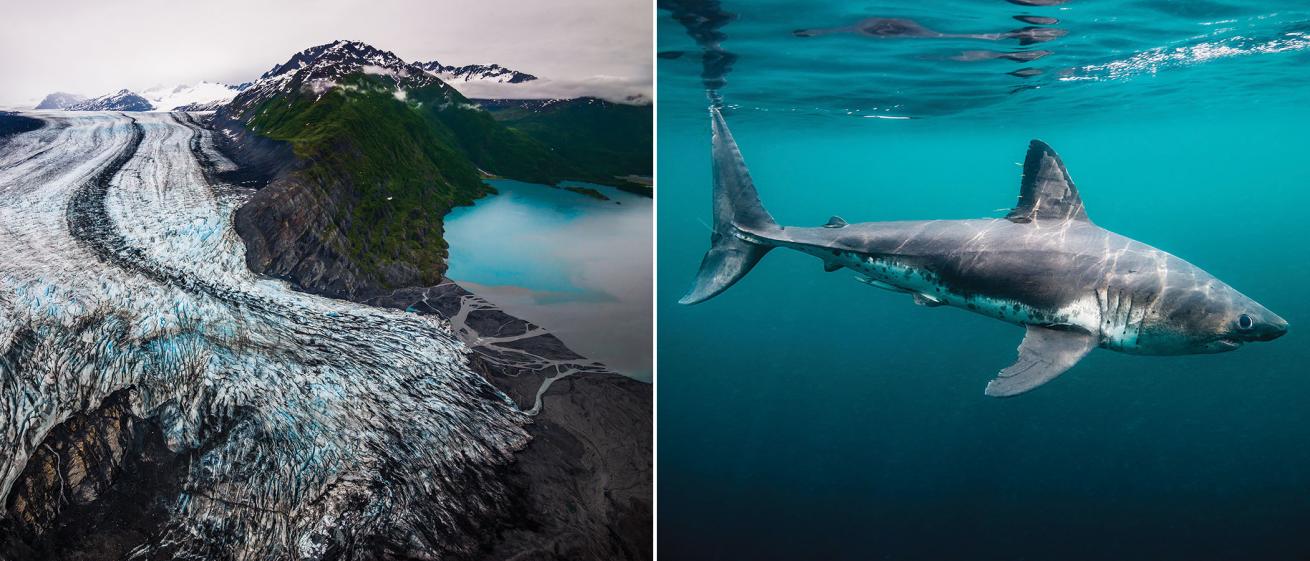
Jennifer IdolAn aerial of Shoup Glacier (left) shows significant glacial retreat; a male salmon shark descends in Prince William Sound.
Prince William Sound
Alaska, USA
Alaska is one of our last great wildernesses, with remote diving amid prolific wildlife. I first experienced Resurrection Bay from Seward with Dive Alaska on my quest to dive all 50 states. Invertebrate life dominated, from lion’s mane jellyfish to giant plumose anemones. I learned that salmon sharks inhabit Alaska and returned to dive with them in Prince William Sound. I visited Ravencroft Lodge, where not only did I see salmon sharks, but also jellyfish smacks that rival tales of Jellyfish Lake in Palau. Orcas, Dall’s porpoises, and soaring bald eagles dotted the landscape. While I don a drysuit, diving in summer is not a cold endeavor. Alaska is the first place I’ve found that’s big enough for my imagination, drawing me back again and again. — Jennifer Idol
Three Things to Look For
- Look Sharp Observing salmon sharks is a snorkeling endeavor that raises adrenaline from hours searching for them, punctuated by lightning-fast, fleeting encounters.
- Smack Attack Look for hazy water that resolves into moon jelly smacks as deep as your limits allow, and dense enough to block any sight of your buddy.
- Parts Is Parts Elusive giant Pacific octopuses can be found by looking for parts of tentacles or movement under rocks at the edges of plumose anemone fields.
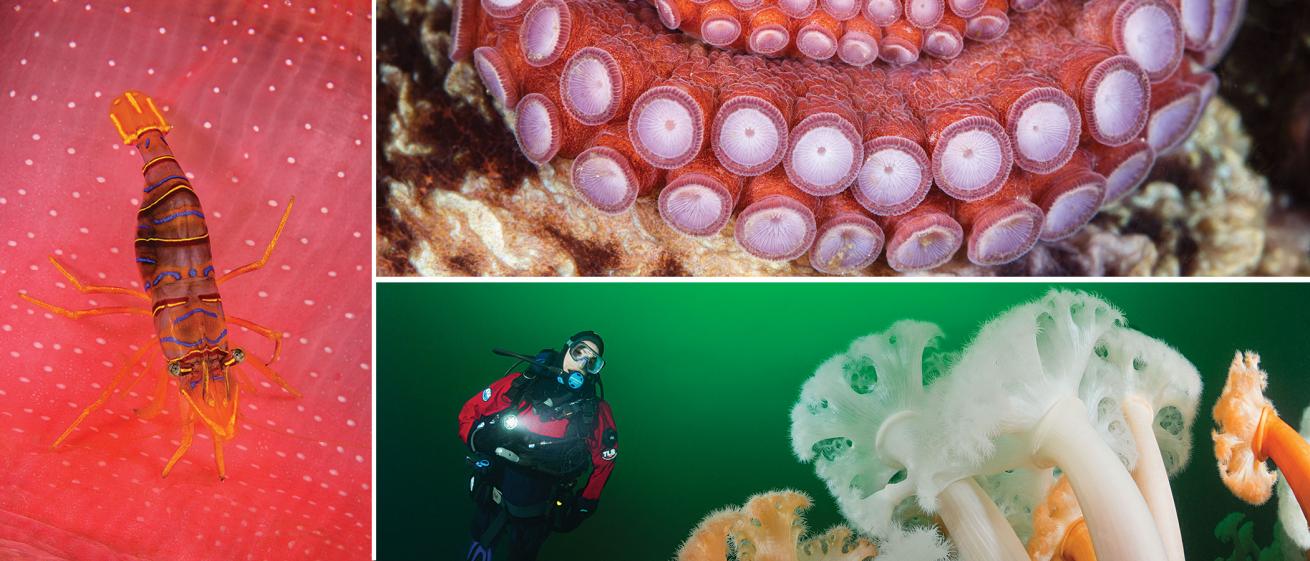
Brandon Cole(Clockwise, from left) A candy stripe shrimp on its crimson sea anemone home; giant Pacific octopus suckers; plumose sea anemones thrive on the Cape Breton shipwreck.
Vancouver Island
British Columbia, Canada
Four C’s sum up scuba diving around BC’s Vancouver Island: cold, current, color and critters. My drysuit conquers the first challenge, while careful planning — I dive during slack, the mellow period between swift tidal exchanges — helps me survive the second. Properly prepared, I revel in the C’s born of the nutrient-powered marine machine ever at work in the rich waters off Canada’s westernmost province. My five fave dive regions, each worthy of a weeklong expedition (or more), are Port Hardy atop the north, Barkley Sound on the west, Victoria to the south, and Campbell River and Nanaimo sharing the east. Even with more than 2,000 dives logged around this remarkable 300-mile-long island, I have only just begun to scratch below the surface. — Brandon Cole
Three Things to Look For
- Big Critters This is the realm of the giant Pacific octopus, playful Steller sea lions twice your size, and Muppet-faced wolf eels. Even anemones grow to epic proportions.
- Get Wrecked Nanaimo is shipwreck central, with a fleet of purpose-sunk vessels awaiting exploration, and choices for both rec and tec skill levels.
- Art Made Easy One magically becomes Monet when pointing a camera at lush walls smothered in sponges, anemones and soft corals.
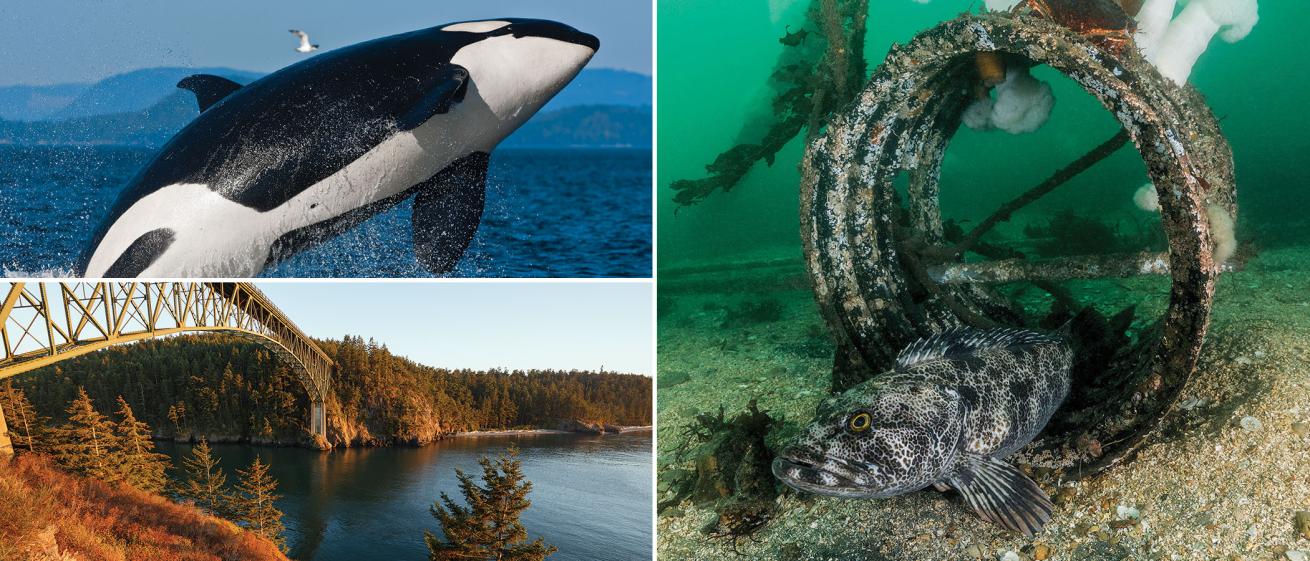
Brandon Cole(Clockwise from top left) An orca breaches off the coast of Washington; huge lingcod are found in Washington’s artificial reefs; a view of Deception Pass State Park, where a dive site can be found under the bridge.
Puget Sound
Washington, USA
With abundant marine life and dozens of excellent shore sites, settling in the Evergreen State 30 years ago was a no-brainer for me. I was always feverishly saving pennies for my next air fill: The cheap 24/7/365 access to kelp beds, walls, artificial reefs, boulder fields and muck sites was irresistible. It still is. These days I occasionally upgrade to boat excursions to reach sites too far from water’s edge, but the majority of my bottom time still begins with a hike, cameras in tow. Puget Sound’s protection from the ravages of the open Pacific is another huge bonus, allowing me to splash in peace, even when winter storms are hammering the outer coast. From Whidbey Island down to the bottom of Hood Canal, Washington’s inland waterways are a phenomenal place for divers to call home. — Brandon Cole
Three Things to Look For
- Man-Made “Build it and they will come” is the mantra at Edmonds Underwater Park, where a jungle gym of beams and boats is a magnet for marine life such as lingcod, cabezons and rockfish.
- Dive In Puget Sound’s scuba scene is hopping with fun people, active dive clubs and top-notch dive shops. Wherever your interests lie, Washington’s dive tribe is quick to welcome newbies and veterans.
- Weird and Wonderful Experience nightly freak shows under Seattle’s skyline at sites such as Alki Junkyard and Cove 2, where you can find bearded poachers, stubby squids, grunt sculpins and warbonnets.
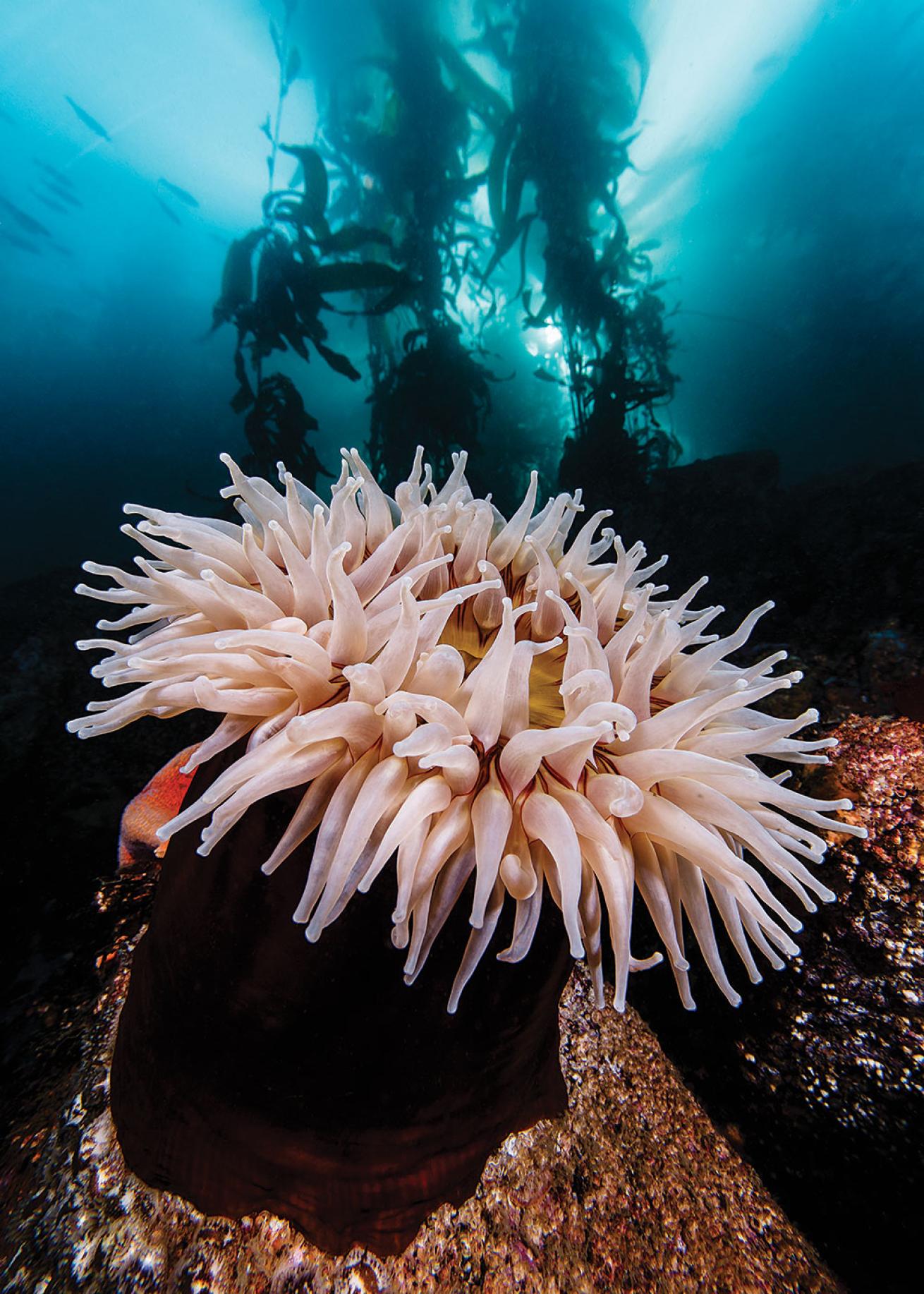
Andrew SallmonA fish-eating anemone sits beneath kelp in the Monterey Bay National Marine Sanctuary.
Monterey
California, USA
I’m 60 feet down at Point Lobos Marine Reserve, and it feels like I’ve traveled 60 years into the past. Only five minutes into my dive, I’ve passed three dog-size cabezon and come face to face with the largest lingcod I’ve ever seen, a toothy monster nearly 4 feet long. Above me, a dense school of blue rockfish moves lazily through the kelp canopy; below, every rock is obscured by thick invertebrate life. This area has been protected for decades, and the pristine results are astounding. It’s little wonder this is the crown jewel of central California diving — and that’s saying something, since the Monterey/Carmel region is so jampacked with remarkable sites that it attracts divers from all over the globe. — Allison Vitsky Sallmon
Three Things to Look For
- Awesome Anemones From fluffy white plumose giants to jewel-like corynactis and showy, fish-eating beauties, Monterey’s waters are loaded with these lovely invertebrates.
- Sea Nettle Jellyfish Few experiences are more mesmerizing than diving with these pulsing, golden invertebrates. Blooms are localized and transient, so if you hear of one, plan a dive immediately.
- Big Sur Coastline It’s well worth taking a surface interval to drive along this stretch of Highway 1 and view the vistas touted as some of the most gorgeous in the United States.
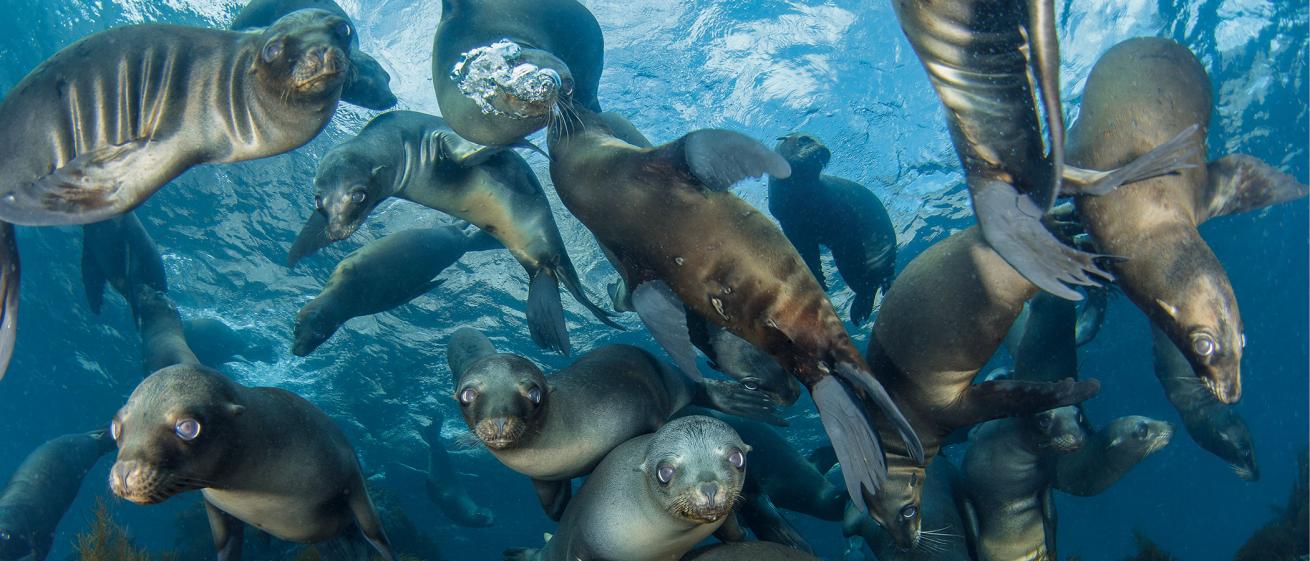
Allison Vitsky SallmonA mass of California sea lions mugs for the camera at the sea lion rookery off California’s Santa Barbara Island.
Channel Islands
California, USA
My love affair with kelp began during my first dive at Santa Barbara Island, the southernmost of the Channel Islands National Park. The park is a vast, diverse area encompassing five distinct islands — Santa Barbara, Anacapa, Santa Cruz, Santa Rosa and San Miguel — and hundreds of dive sites; a feature of most is the towering giant kelp. In the years since my first kelp dive, I’ve explored as many of these sites as I possibly could, and though the water color and denizens differ from island to island, the sun rays piercing the majestic kelp forests are the common thread that continues to fuel my passion for classic California diving. — Allison Vitsky Sallmon
Three Things to Look For
- Playful Pinnipeds Raucous California sea lions are a main attraction at Santa Barbara Island, but pinniped encounters are common throughout the islands.
- Northern Nudis These colorful, delicately beautiful invertebrates can be found all over, but they are especially common and varied in the northernmost islands.
- Seeing Red And orange; the islands’ most photographable subjects — including gorgonians, garibaldi, cabezons and fish-eating anemones — are easy to spot.
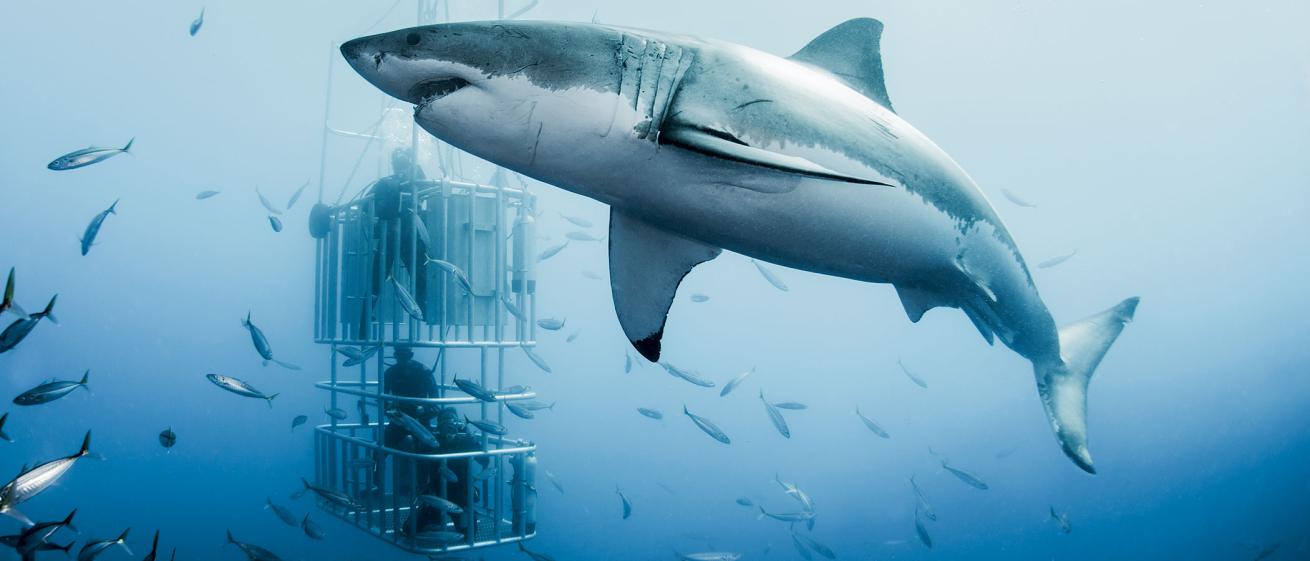
Davide LoprestiA great white shark patrols the water off Isla Guadalupe while photographers view from a cage.
Isla Guadalupe
Baja California, Mexico
What makes diving with the white shark unique and fascinating is the awareness of being in front of an animal that is not at all intimidated by us. It simply observes — when it approaches the cage, you can almost feel the gaze of that incredible black eye. Isla Guadalupe is the perfect destination: It’s not easy to reach, but the crystal-clear water and plethora of white sharks do justice to the long crossing. Contrary to what you might think, you never feel fear around these sharks, only a profound respect for one of the most ancient predators of the sea, so powerful and so fragile at the same time, and threatened by a changing climate. — Davide Lopresti
Three Things to Look For
- Roll Call Each white shark at Guadalupe is photographed and cataloged; the shape of the fins and its side spots are unique identifiers, like our fingerprints.
- Life Lessons Adult sea lions chase young sharks and bite their fins, thought to be an attempt by the pinnipeds to dissuade sharks from developing a taste for sea lion.
- Island Origins This UNESCO World Heritage Site constitutes the summit of a volcanic cone that emerged more than 150 miles off the coast of Baja California.
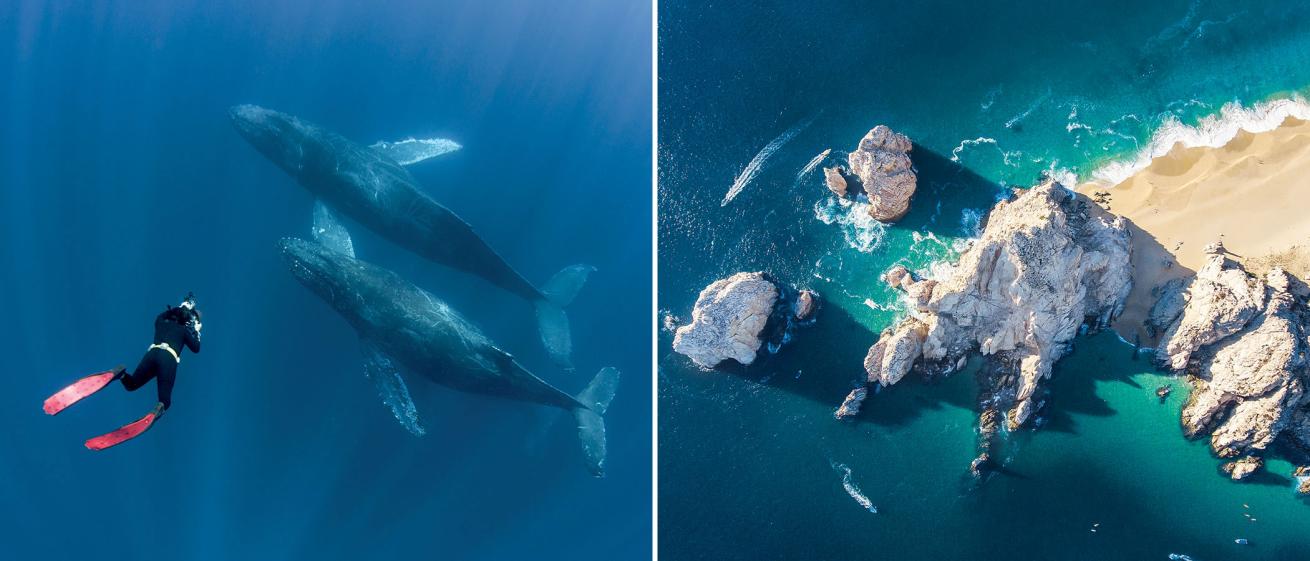
Shane Gross; Noam KortlerHumpback whales pass by the coast of Cabo San Lucas (left) while migrating for the winter; a view of the arch at Land’s End.
Cabo San Lucas
Baja California Sur, Mexico
Cabo San Lucas was once synonymous with bachelorette parties and Spring Break, but that image masks a key draw: There’s great diving here. New divers can get comfortable close to Lover’s Beach at Pelican Rock, which starts at about 20 feet. Deeper pinnacles — up to 120 feet — with frogfish, tarantula-like crabs, nudis, scorpionfish and other macro life engage advanced divers. To the east there’s Sand Falls, product of a 3,000-foot trench that creates a “waterfall” as grains cascade into the abyss. Everybody gets a kick out of the omnipresent playful sea lions, along with mobula rays, baitballs, and schools of parrot, surgeon and barberfish. North and east, dive sites are flung out across mammoth Bahia San Lucas, where humpback whales are not uncommon. — Mary Frances Emmons
Three Things to Look For
- Hide-and-Seek Baby sea lions are a trip, and the moms are chill with divers. But best to mind your manners when large males bomb through to check on their harems.
- Now You See It Just past the Arch, at a site called the Point, the cargo ship Lundenberg was uncovered by Hurricane Odile in 2014, creating a whole new playground.
- How the Other Half Lives If you’re into boat porn, you’ll get an eyeful at the Cabo San Lucas marina, where some of the world’s most amazing yachts are regulars.

